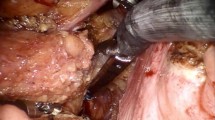Abstract
Background
We experienced some technical difficulty in dividing the middle and lower rectum through the right-lower quadrant intracorporeally. The aim of this study was to determine whether multiple stapler firings during rectal division are associated with anastomotic leakage after laparoscopic rectal resection.
Methods
Laparoscopic anterior resection with double-stapling technique anastomosis was performed in 180 consecutive rectal cancer patients. We often used vertical rectal division through a suprapubic site instead of the standard transverse rectal division for laparoscopic total mesorectal excision (LapTME). We attempted to determine whether there was an association between the number of stapler firings and procedures in rectal division. Moreover, we identified risk factors for anastomotic leakage after laparoscopic rectal resection by multivariate analysis.
Results
Anastomotic leakage occurred in 5% of the subjects of this study. Vertical rectal division through the suprapubic site after Lap TME required fewer staples than transverse division through the right-lower port and a smaller percentage of patients required three or more staples for vertical rectal division than for transverse division (15% vs. 45%, p = 0.03). In the multivariate analysis, TME and the number of staplers used for rectal division were the factors found to be associated with a significantly greater risk of subsequent leakage (odd’s ratio = 5.3; 95% CI 1.2–22.7 and odd’s ratio = 4.6; 95% CI 1.1–19.2).
Conclusion
TME and multiple stapler firings during distal rectal division were associated with anastomotic leakage after laparoscopic rectal resection. Vertical rectal division through a suprapubic site was a useful method of avoiding multiple stapler firings during laparoscopic TME.

Similar content being viewed by others
References
Polliand C, Barrat C, Champault G (2005) Laparoscopic resection of low rectal cancer with a mean follow-up of 7 years. Surg Laparosc Endosc Percutan Tech 15:144–148
Yamamoto S, Watanabe M, Hasegawa H, Kitajima M (2002) Prospective evaluation of laparoscopic surgery for rectosigmoidal and rectal carcinoma. Dis Colon Rectum 45:1648–1654
Hartley JE, Mehigan BJ, Qureshi AE, Duthie GS, Lee PW, Monson JRT (2001) Total mesorectal excision: assessment of the laparoscopic approach. Dis Colon Rectum 44:315–321
Morino M, Parini U, Giraudo G, Salval M, Brachet Contul R, Garrone C (2003) Laparoscopic total mesorectal excision: a consecutive series of 100 patients. Ann Surg 237:335–342
Law WL, Lee YM, Choi HK, Seto CL, Ho JW (2006) Laparoscopic and open anterior resection for upper and mid rectal cancer: an evaluation of outcomes. Dis Colon Rectum 49:1108–1115
Kim SH, Park IJ, Joh YG, Hahn KY (2006) Laparoscopic resection for rectal cancer: a prospective analysis of 30-month follow-up outcomes in 312 patients. Surg Endosc 20:1197–2002
Lelong B, Bege T, Esterni B et al (2007) Short-term outcome after laparoscopic or open restorative mesorectal excision for rectal cancer: A comparative cohort study. Dis Colon Rectum 50:176–183
Scheidbach H, Schneider C, Konradt J et al (2002) Laparoscopic abdominoperineal resection and anterior resection with curative intent for carcinoma of the rectum. Surg Endosc 16:7–13
Zaheer S, Pemberton JH, Farouk R, Dozois RR, Wolff BG, Ilstrup D (1998) Surgical treatment of adenocarcinoma of the rectum. Ann Surg 227:800–811
Seidell JC, Flegal KM (1997) Assessing obesity: classification and epidemiology. Br Med Bull 53:238–252
MacFarlane JK, Ryall RDH, Heald RJ (1993) Mesorectal excision for rectal cancer. Lancet 341:457–460
Yeh CY, Changchien CR, Wang JY et al (2005) Pelvic drainage and other risk factors for leakage after elective anterior resection in rectal cancer patients: a prospective study of 978 patients. Ann Surg 241:9–13
Salerno G, Daniels IR, Brown G, Norman AR, Moran BJ, Heald RJ (2007) Variations in pelvic dimensions do not predict the risk of circumferential resection margin (CRM) involvement in rectal cancer. World J Surg 31(6):1313–1320
Dulucq JL, Wintringer P, Stabilini C, Mahajna A (2005) Laparoscopic rectal resection with anal sphincter preservation for rectal cancer: long-term outcome. Surg Endosc 19:1468–1474
Rullier E, Laurent C, Garrelon JL et al (1998) Risk factors for anastomotic leakage after resection of rectal cancer. Br J Surg 85:355–358
Ishida H, Hashimoto D, Nakada H et al (2002) Increased insufflation pressure enhances the development of liver metastasis in a mouse laparoscopy model: possible mechanisms. Surg Endosc 16:331–335
Author information
Authors and Affiliations
Corresponding author
Rights and permissions
About this article
Cite this article
Ito, M., Sugito, M., Kobayashi, A. et al. Relationship between multiple numbers of stapler firings during rectal division and anastomotic leakage after laparoscopic rectal resection. Int J Colorectal Dis 23, 703–707 (2008). https://doi.org/10.1007/s00384-008-0470-8
Accepted:
Published:
Issue Date:
DOI: https://doi.org/10.1007/s00384-008-0470-8




